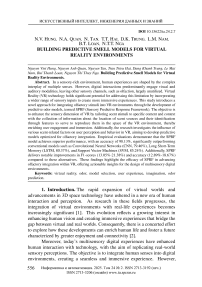Создание прогнозирующих моделей запахов для сред виртуальной реальности
Автор: Нгуен Вьет Хунг, Нгуен Ань Куан, Нгуен Тан, Тран Триеу Хай, Данг Тхань Чунг, Ле Май Нам, Буй Тхань Лоан, Нгуен Тхи Туй Нга
Журнал: Информатика и автоматизация (Труды СПИИРАН) @ia-spcras
Рубрика: Искусственный интеллект, инженерия данных и знаний
Статья в выпуске: Том 24 № 2, 2025 года.
Бесплатный доступ
In a sensory-rich environment, human experiences are shaped by the complex interplay of multiple senses. However, digital interactions predominantly engage visual and auditory modalities, leaving other sensory channels, such as olfaction, largely unutilized. Virtual Reality (VR) technology holds significant potential for addressing this limitation by incorporating a wider range of sensory inputs to create more immersive experiences. This study introduces a novel approach for integrating olfactory stimuli into VR environments through the development of predictive odor models, termed SPRF (Sensory Predictive Response Framework). The objective is to enhance the sensory dimension of VR by tailoring scent stimuli to specific content and context with the collection of information about the location of scent sources and their identification through features to serve to reproduce them in the space of the VR environment, thereby enriching user engagement and immersion. Additionally, the research investigates the influence of various scent-related factors on user perception and behavior in VR, aiming to develop predictive models optimized for olfactory integration. Empirical evaluations demonstrate that the SPRF model achieves superior performance, with an accuracy of 98.13%, significantly outperforming conventional models such as Convolutional Neural Networks (CNN, 79.46%), Long Short-Term Memory (LSTM, 80.37%), and Support Vector Machines (SVM, 85.24%). Additionally, SPRF delivers notable improvements in F1-scores (13.05%-21.38%) and accuracy (12.89%-18.67%) compared to these alternatives. These findings highlight the efficacy of SPRF in advancing olfactory integration within VR, offering actionable insights for the design of multisensory digital environments.
Виртуальная реальность, запах, выбор модели, пользовательский опыт, воображение, прогнозирование запахов
Короткий адрес: https://sciup.org/14132951
IDR: 14132951 | УДК: 006.72 | DOI: 10.15622/ia.24.2.7


